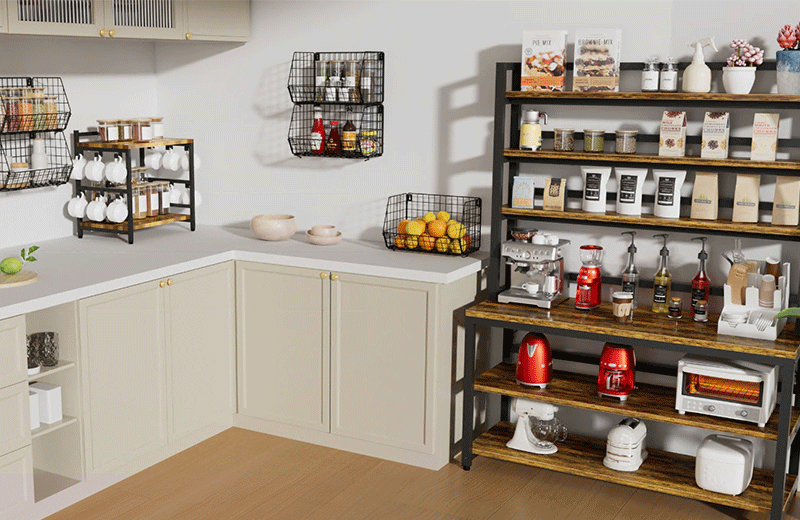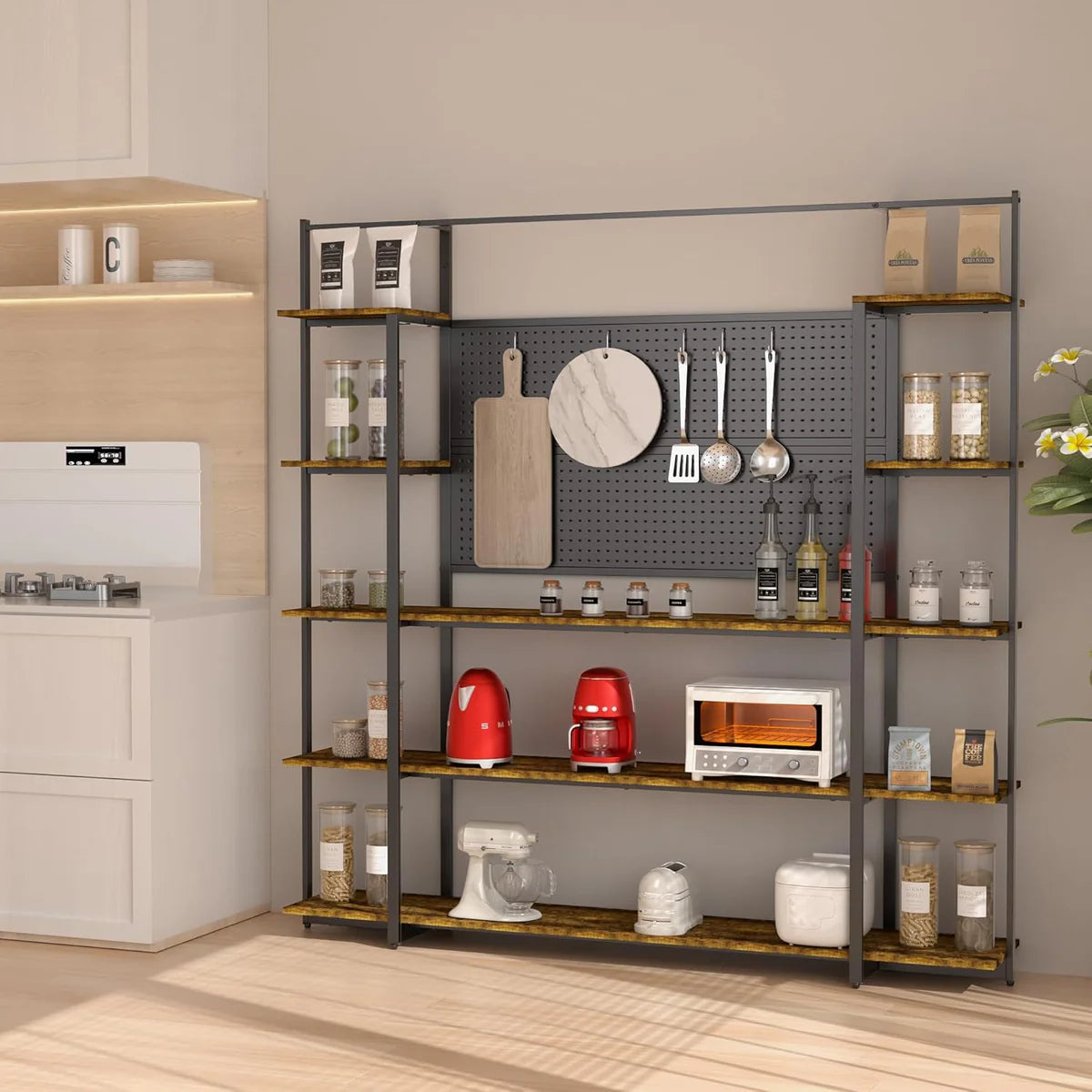Bakers racks, also known as kitchen shelves or utility racks, are versatile pieces of furniture widely used in kitchens, restaurants, and even home decor settings. Their open-shelf design provides ample storage space for kitchenware, ingredients, or decorative items, making them an excellent addition to any space that requires efficient organization and style. The construction of these racks varies, with different materials offering unique benefits in terms of durability, aesthetics, and cost. In this article, we will explore the most commonly used materials to make baker's racks and delve into the advantages and considerations associated with each.
1. Wood
Wood is perhaps the most traditional and widely recognized material used for making baker's racks. It offers a warm, natural aesthetic that can seamlessly blend with various interior decor styles, from rustic farmhouse to contemporary modern. Different types of wood bring their unique characteristics:
- Pine: Known for its softness and knots, pine offers a rustic, country charm. It’s relatively inexpensive and easy to work with but may require more frequent maintenance to prevent scratches and dents.
- Oak: Harder and more durable than pine, oak provides a rich, dark grain that ages gracefully. It’s more expensive but offers excellent resistance to wear and tear.
- Maple and Cherry: These hardwoods are known for their fine grain and smooth texture, making them ideal for high-end, polished looks. They are also durable but come at a premium price.
- Plywood and MDF (Medium-Density Fiberboard): Engineered woods like plywood and MDF are cost-effective alternatives to solid wood. They are made from layers of thin wood or wood fibers bonded together, offering a smooth, uniform surface. However, they may not be as durable as solid woods and are prone to swelling if exposed to moisture.
Wooden baker's racks can be finished with paints, stains, or varnishes to enhance their appearance and protect against damage. Regular cleaning and occasional refinishing can keep them looking their best.
2. Metal
Metal is another popular choice for baker's racks, particularly in industrial or modern settings. Its strength and durability make it well-suited for heavy-duty use, while its sleek, clean lines add a contemporary touch to any space. Common metals used include:
- Steel: Known for its strength and versatility, steel can be either powder-coated for a matte finish or polished to a high shine. It’s resistant to rust if properly coated and can support heavy loads without bending.
- Iron: Wrought iron and cast iron offer intricate designs and classic, ornate aesthetics. While cast iron is heavier and more durable, wrought iron provides a lighter yet still sturdy alternative. Both require occasional rust prevention treatments, especially in humid environments.
- Aluminum: Lightweight yet strong, aluminum is corrosion-resistant and often used in outdoor or high-moisture areas. It’s easy to clean and maintain, making it a practical choice for busy kitchens.
Metal baker's racks can come in welded or bolted constructions. Welded racks are more stable and less prone to loosening over time but may be more challenging to disassemble for moving. Bolted racks, on the other hand, offer easier assembly and disassembly but might require periodic tightening to maintain stability.
3. Combination of Wood and Metal
Combining wood and metal in baker's racks creates a hybrid that leverages the strengths of both materials. Wood provides the warm, inviting aesthetic, while metal adds structural support and a modern flair. This combination is particularly popular in rustic-industrial or farmhouse-modern designs:
- Wood Shelves with Metal Frames: The shelves are made of wood, often pine or oak, while the supporting frame and legs are crafted from metal, usually steel or wrought iron. This blend offers a sturdy construction with a touch of warmth.
- Metal Grids with Wooden Supports: In some designs, the actual shelving surface is a metal grid, providing ventilation for items like baking sheets, while wooden supports or trim add a decorative and functional edge.
This combination often requires careful consideration during the finishing process to ensure a cohesive look. Matching the metal finish (such as brushed steel or polished iron) with the wood tone (light oak or dark mahogany) is crucial for achieving a balanced aesthetic.
4. Plastic and Laminate
Plastic and laminate materials are less common in traditional baker's racks but have gained popularity in recent years due to their affordability, lightweight nature, and ease of cleaning. These materials are particularly suited for budget-conscious consumers or those seeking a modern, minimalist aesthetic:
- Plastic: Often molded into sleek, contemporary shapes, plastic baker's racks are lightweight and easy to move around. They are resistant to moisture and stains, making them ideal for humid environments like kitchens or bathrooms. However, they may lack the durability and longevity of wood or metal.
- Laminate: Laminate shelves are made from compressed particle board or MDF covered with a decorative, protective layer. They offer a wide range of finishes that mimic wood grains or solid colors, providing a high-end look at a fraction of the cost. Like plastic, they are easy to clean but may scratch or chip over time.
When choosing plastic or laminate baker's racks, it’s important to consider the quality of the material. Thicker, more durable plastics and high-pressure laminates will offer better performance and longer lifespans.
5. Bamboo and Rattan
For a unique, eco-friendly option, bamboo and rattan baker's racks are gaining traction among those who appreciate natural materials and sustainable design. Both materials offer a lightweight yet strong alternative to traditional woods:
- Bamboo: Bamboo is a fast-growing grass that is both renewable and strong. It’s used to create sleek, modern racks with a natural, tropical charm. Bamboo is resistant to mildew and insects, making it a durable choice for indoor use.
- Rattan: Rattan is a vine-like plant that, when woven, creates intricate, elegant designs. Rattan baker's racks often feature woven shelves or frames, adding a touch of bohemian flair to any space. They require gentle cleaning and may not be as sturdy as solid woods or metals.
Both bamboo and rattan racks are lightweight and easy to move, making them ideal for renters or those frequently rearranging their living spaces. However, they may not be as durable as hardwood or metal options and may require more delicate handling to prevent cracking or breaking.
Conclusion
The choice of material for a baker's rack ultimately depends on personal preference, budget, and the specific needs of the space. Wood offers a timeless, warm aesthetic; metal provides strength and modernity; combinations of wood and metal create a balanced, versatile look; plastic and laminate offer affordability and ease of care; while bamboo and rattan bring a natural, eco-friendly touch. Each material has its own set of advantages and considerations, making it essential to weigh all factors before making a decision. By selecting the right material, you can ensure that your baker's rack not only serves its functional purpose but also enhances the beauty and ambiance of your home or business.







